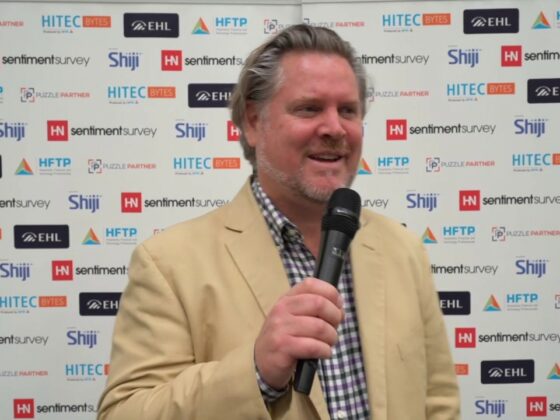Josiah: Tim and Dan, thank you so much for taking the time to record today. I’ve been excited to speak with you. As many of my listeners know, one of the top challenges that I found that’s going to surprise nobody, but I found across the industry in my recent State of the Hotel Industry Survey is hoteliers are challenged by driving revenue and driving profits, right? You both are building a company that focuses on this. You’ve done so much over your respective careers in moving towards this and helping hotels with this. So I appreciate you both making the time to talk. Tim, I’m going to hand it to you first. I would love if you could explain a little bit about your company and then your career journey that led you to today and the work that you’re doing.
Tim: Yeah, absolutely. So Revenue Generation is really a team of dedicated professionals focused on delivering long-term sustained results for their clients, our partners. And we really emphasize the word partner because, you know, a true partnership really equals real results. And so we’re focused on that. We specialize in commercial strategy consulting for hotel portfolios. as well as individual hotels. And not only that, but we have a fairly new client that is in the wedding venue business. So we’re moving to a little bit different vertical there as well. So we provide third party revenue optimization. We provide training. And one of the largest areas of focus that we have really is around the area of the analytics, business intelligence and applying data science. So we build custom platforms for our clients to achieve that, which obviously in where we are as an industry right now is a really important place to be. So what kind of led me to this, I’ve been in the hotel business my entire career. Started off as a reservation agent in Omaha, Nebraska, just as a part-time job, and sort of became intrigued by it. What really intrigued me the most was how hotels make decisions around pricing. And so I went from there to hotel level up in Canada. I spent 15 years in Canada, 10 of it with Starwood Hotels, and then five with another hotel private equity firm. I sort of grew up in the revenue management discipline, that curiosity stayed with me and started applying some rudimentary revenue management applications to the hotels that I was managing. Apparently Starwood liked it, so they kept on promoting me to different hotels, larger hotels. And then my boss, who has been a real mentor for me in many ways throughout my career, Manaz Abji, who is now retired and enjoying life, took me along to a portfolio of hotels, Canadian Hotel Uncon Properties, brand new real estate investment trust. And they would manage and own the hotels and really kind of built out the infrastructure there, started building out revenue tools to assist the revenue managers in making better decisions. From there, I went to the ownership side and moved back to the U.S., joined Host Hotels for a number of years. And that was interesting because it was important for me in my career really to understand the asset management side of the business and the ownership side of the business more. And I certainly learned it from there. Got to interact with the major players, with all the major brands that represented us. So that was a really good experience. Since then, I’ve worked with a private equity firm, a major brand in the U.S., Red Roof Inns. And in 2019, I decided to make a shift in my career instead of going back and forth to different corporate offices. Working in that corporate environment, I decided I wanted to really focus in on the things that I enjoyed the most. And that was the evolution of revenue generation as a company. Of course, COVID happened that gave me a year to kind of think about exactly what we wanted to focus in on more. And since then, we’ve focused on the third party revenue optimization, initially training and then built out platforms from there. And Dan joined me about a year and a half ago, and he’s been a great contributor to where this company has moved to today.
Josiah: Amazing. Well, Dan, I want to get into hearing about your career journey. Tim, amazing to hear about what you’ve done over your career, seen a lot. And I am very curious to hear what you’re hearing as some of the top challenges people in the hotel industry are facing now. It’s a quickly evolving landscape. I’m going to come back to you, Tim, but Dan, pass it over to you. I want to hear a little bit about your journey as well. What led you to your work today?
Dan: Sure, sure. I’ve also spent my career in revenue management, but I’ve applied revenue management in different non-traditional contexts. So coming out of graduate school, started my revenue management career in the casino industry and spent five years in Atlantic City. working for a brand new property that opened in 2003, the Borgata, and then another local company after that. I love the challenge of looking for common threads across different applications of revenue management and not just the ruins also, you know, extending to other kinds of space and restaurants and spas and the casino floor and such, but also looking for those subtle nuances that make each application of revenue management different from the next and really enjoyed that. I moved on from the casino industry to multifamily, and they say about multi-family it’s like hospitality but people stay longer. So yes, a lot of common threads. You are still setting pricing for apartment rentals but you are also doing interesting things that don’t exist in the hotel world like carefully managing when your leases expire in accordance to seasonal demand over the course of the years that you don’t get caught with a lot of apartments during times of the year when not a lot of people need them, and that happens to be a very important aspect of revenue management in the multifamily world. So I spent four years with Archstone Apartments, which was a fairly large REIT in multifamily, and then actually went to work for one of our technology providers, and happened to be, so it was Rainmaker, which happened to be a company that provided revenue optimization solutions for hotels with a focus on casinos. So use their platforms, use their solutions in my casino experience. And they also had a suite of products for multifamily. So I joined them having experience from both worlds and spent a total of almost nine years with Rainmaker and then stayed on after the acquisition by Sendai and stayed on for a couple more years. And I led the the data science function for those companies. So I had a focus on the science side, on the data-driven decision-making. We did a lot, wore a lot of hats. I think what I liked best was driving innovations for the products and solving new and interesting problems to support the revenue and profit optimization goals. So we did things like look at ways to dynamically price room type differentials by looking at historical data on what was actually paid for each room type and being able to identify how guests were truly valuing each room type and then a way to dynamically adjust that based on the demand for the observed demand and the forecasted demand for each type and such. We also looked, we were also very focused still on casinos and looking at ways to, new and innovative ways to value casino patrons and predict the value of casino patrons that extended well beyond the traditional approaches that were in use at the time. And as Tim mentioned, for the last year and a half, we’ve been partnered on addressing new and interesting challenges in revenue management through the use of data. And we were really focusing on building out our business intelligence capabilities, building out data science, prescriptive and predictive analytics, And yeah, bringing those out there to the industry.
Josiah: Well, thank you for sharing that story. I find it fascinating when people apply some skills that are useful in hotels or hospitality in different contexts. And obviously, the world of casinos is kind of in the broader world of hospitality. But I worked for a little while at a revenue management technology company. And before I did that, I had no idea how this all played out. And I got to see casinos are maybe one of the more complex applications of these sort of processes. So if you can kind of operate in that environment, certainly hotel folks that are listening can apply some of the principles of what we’ll talk about. So I’m excited to get into this. I would like to ground the conversation in where we are now. We’re recording this in January 2025, just a timestamp that I know things move quickly here. And I feel like it’s funny looking back. We talked about both of your careers. It’s funny looking back because I feel like history doesn’t repeat, but it rhymes and there’s some cyclical nature of hospitality. But also, Tim, before we started recording, you mentioned this is actually a really pivotal moment. And I’d love to pass it back to you and hear you describe a little bit more about what you see going on in the industry now and why you believe this is a pivotal moment.
Tim: Well, for me, a couple of different factors were for the first time, we’re kind of seeing stabilized occupancies. Business is coming back. Business travelers coming back. Groups, we’re seeing some really nice recovery on the group side, almost fully recovered and even increasing from 2019 levels. But because of COVID as well, I think the focus on the profitability side of the business has increased significantly over the years. I think we learned a lot through COVID about what’s profitable, what’s not profitable. Obviously, expenses have increased significantly. Since then, labor’s gone up significantly. So we do have to focus on that more. And we talked about that for many years prior to COVID, but real practical applications are only starting to begin right now. And so for me, you know, when we talk about how we look at our business from a revenue management perspective, it’s more about profit optimization than it is that ultimate star result that we’ve been so diligent at looking at in the past. So in some instances, and I love to bring this up with my students when I do the CRME training with HSMAI, is go through an exercise where we take a look at a one-star report that has an emphasis on occupancy, and another star report that has an emphasis on rate and actually loses a little bit of RevPAR as a result. But when you start applying the cost per occupied room and other expense factors directly driven by occupancy, in that particular exercise, the second scenario was the one that actually brought more to the bottom line at the end of the day. And for that, for many revenue managers, many directors of sales, GMs, etc. It was an eye-opener for them. So that, I think, is important. We’re also, you know, we talk a lot about AI now. And we’ve applied AI for a number of years, we just didn’t call it that in the past. But I think that now is an opportunity for us and there’s a lot of focus on it. And when we go back to our owners and say, hey, we need this technology, now’s a really good opportunity for us to be able to give some reasons why. Because there are others out there that are using it and finding success with it.
Josiah: Fascinating. Dan, I’d love your take on this as well. What are you seeing and hearing out there in the industry with regards to revenue generation and profitability?
Dan: Yeah, I’ll echo everything that Tim said as accurate and just to kind of pick up where Tim left off. Definitely a lot of A lot of hype, for lack of a better term, over the last few years around AI. And I think it’s important to sort of distinguish a couple of different flavors. The chatGPT and the large language modeling over the last few years has been in the spotlight. And I would contrast that with what Tim mentioned, the sort of flavor of AI that’s been around for a while. the predictive and prescriptive analytics. And certainly in our industry, it’s been there the whole time with varying degrees of adoption. I think it’s important, as I think Tim mentioned to, or maybe you mentioned Josiah, to lay the foundation if you’re just getting going with it and understand what that looks like. And know that it’s not too late. There’s a lot of A lot of interesting discussions about where we can go with AI and sort of this new flavor of AI, but important to make sure you’re already set up for success to do that. And that might look like being able to harness what has already been out there, use it to your advantage. if you’re not already before you take that next leap. So, yes, I think that there’s a lot of discussion around that, a lot of possibility, but as I said earlier, there’s a practical approach to getting there.
Josiah: So one thing I’d love to get your take on, Tim, maybe yours as well, is in this state of the hotel industry research I did, I was asking different groups about, do you want to see more AI used in hospitality? By a considerable margin, hotel owners and investors wanted to see AI adopted more than any other group, brands, operators, people on the front lines of hospitality. Owners seemed very interested in AI. What might be causing that?
Dan: I think that there are undoubtedly efficiencies that get created through being able to solve problems with the help of AI and perhaps automating solutions, automating processes, and seeing the ROI on that. Another trend I see a lot of discussion around in the last five years or so is what the day-to-day and week-to-week tasks of a revenue manager and how much of that is actually focused on revenue strategy and revenue generating activities. And I think there was some research done on that where maybe it was half or slightly less than half of the time spent on actually generating revenue and the rest, you know, was synthesizing, obtaining, synthesizing, compiling, managing the data, which important, obviously, to the overall effort, but at the end of the day, not as productive as you would like it to be. So I’m sorry, getting back to your question. Perhaps owners see the opportunity to be able to scale the effort, especially with larger enterprises, scale the effort better, utilize manpower more effectively and efficiently. But again, there are some, I think, simpler first steps to take that on. Take things like automation and being able to ease the burden on revenue managers. And before getting to this end state where perhaps AI is in control of all of it, which I would argue maybe shouldn’t be the case, but we can talk about that as well.
Josiah: I do want to circle back on that. I want to come back to what you mentioned, though, about building a foundation, right? Because it seems to get the most out of AI now and in the future. It needs to be built on top of something, and that something is likely to include data. I think both of you have touched on that. I wonder if we could speak for a few minutes about how practically can you build a foundation or set yourself up to benefit from the potential of AI? It seems like there’s something our listeners could maybe be thinking about or doing now. I’d love to get your thoughts on that.
Dan: One thing I see a lot with a few of the clients that we work with is that they’re at various stages of obtaining, working with data, cleaning the data, managing the data, etc. And I think taking a deliberate approach or having a strategy towards that activity, towards those activities, I should say, is a good first step. Understanding what your sources are, understanding how you define each data element, making sure you’re being consistent with that, and that if occupancy is defined in a certain way in one place, that you’re consistent across everywhere else that you happen to be calculating something like occupancy as an example.
Josiah: What are some of the most important sources? You mentioned kind of deciding what sources, I guess as it relates to revenue and profitability, what would some of those inputs be that are most critical?
Dan: Yeah, yeah. I mean, I think that you want to make sure that you have decided on a single source of truth. And from my perspective, whether it’s the PMS or the CRS that perhaps provides you with your, your first-hand, your primary source of data, and then building on that. And the reason I say that is that there are a lot of secondary source systems that come into play, I think, in your ecosystem, like some of the third-party competitive rate, the rate shopping solutions or your OTAs or your revenue management system solution providers that can also source that same data, also synthesize it in a certain way and sort of pass it back to you. where it’s already been manipulated in some way, shape or form. And that’s obviously certainly usable. Those are usable sources of data also, but once that manipulation has happened, then you’re susceptible to perhaps, you know, so as you start to run into differences in how something is calculated or a disconnect or whatnot, but I know I’m getting into a bit of detail here, but I think it’s important to sort of understand broadly what the potential caveats and pitfalls are as you kind of proceed in that effort.
Josiah: Yeah, Tim, I’d love to get your take on this because you had an article recently, I’ll link in the show notes because I’d like people to read it. But I guess staying on this topic of building a foundation, I think you took the focus on looking at from a BI or business intelligence perspective. And I guess as you think about BI specifically, what are some of the components of that foundation in that area?
Tim: So I think first and foremost is educating everyone as to what BI is and what it means for their different disciplines. We historically have kind of worked in a siloed environment, revenue management, sales, marketing, operations, finance, et cetera. So first and foremost would be to try to break down those silos from a data standpoint and really understand what available data is out there for us, both internally and externally. And start simple, like Dan mentioned. You’re a single source of truth, so you start from there. And then adopt some type of tool that you can use to start creating insights, whether that be Power BI if you’re an individual or a small portfolio, or Tableau, or there’s some off-the-shelf BI tools out there as well. But really kind of upskilling the team, making sure that they understand the possibilities. Start out simple, create those efficiencies first, make sure that your data is clean, and make sure everyone kind of buys into it.
Josiah: And then secondly, actually, Tim, could I just get some insight from you on this? Because I think that that part of communicating what the potential is is so important. Right. And I think making any change happen feels like you have to be almost sell it to some extent. I guess if you think about individuals that are listening to this, they want to drive change in their organization. How would you, I guess, at a very kind of high level or simple way communicate the power of what B.I. could bring a hotel business?
Tim: Yeah, so I’ll just use an example of a client that we started working with a couple years ago. This client is a wedding venue. They have 75 different venues across the country. They have a lot of data and they had a lot of manual processes in place to help them with forecasting, set pricing, etc. And the VP of sales took my course and after the course reached out to me and said, we got to do something different than what we’re doing right now because all I’m doing is sitting here creating reports, redoing it, et cetera. So I said, if you don’t mind sharing your data with us, we can kind of go through a discovery process, which Dan and I went through with them. And at the end of it, we really outlined what the possibilities were for them. So from a forecasting standpoint, it wasn’t more of a kind of a manual process, but we really applied data science to it. and showed them, you know, in examples of what we could do there. From a space optimization standpoint, we broke out every venue by day part, by day, and showed them the possibilities of what flexing menu prices and minimums would be for these particular venues, but also give them insight as to the likelihood of that particular venue booking on whatever particular day that they were inquiring about. And then other sales tools that really helped the salespeople guide them through the process of quoting, et cetera. So that was a prime example. It gave them a much greater situational awareness. And I think that’s probably the biggest thing when we talk to clients is, really getting a 360 view of the entire situation that they’re in and gives them direction as to where they go. So when you apply data science, you can build a lot of reports that may suggest certain things, but data science will kind of take that to a whole new level. Dan can kind of speak to it more eloquently than I can, but when you do that, the possibilities really increase significantly.
Josiah: Interesting. So it seems like this isn’t just technology for the sake of it. It’s to make better decisions, right? The data science is to make better decisions, more profitable decisions. Your business becomes better. And if I’m thinking back to what we mentioned at the beginning of this conversation, maybe this is the pivotal fork in the road, if you will, because it feels like technology is only accelerating. It feels like the need for profitability has never been higher. So that’s why decision-making is so important. It’s always been important, but this is why it’s so important right now. Is that a fair?
Tim: That’s a very fair assessment.
Dan: I’ll amend that and say make better decisions faster also. I love the term speed to insight because you could be spending hours upon hours sifting through the very same data that we build our BI solutions upon. But hours and hours manipulating it, assembling it, putting a chart together or something, and then saying, aha, I have the answer, right? And it could be the very same thing, the very same outcome, but the fact is that with some technology, with some solution, you’ve gotten there much, much faster.
Josiah: Dan, I’d love to hear your take actually on why is speed to insight or speed to decision so important in today’s operating climate?
Dan: because you can make more of those fast decisions. And the faster you make those decisions, the quicker you realize the benefit. And I will add that presumably you’ve saved someone time somewhere in that process, or perhaps many people time somewhere in that process. And that means that maybe you’ve made their lives easier, their jobs easier, you’ve made them happier, or you’ve freed up that time to perhaps add some new and exciting and different responsibility. which would make their lives easier and more interesting and perhaps, you know, be a path towards career advancement or maybe just a little bit more breathing room or maybe the ability to scale the effort across the organization, right? So you achieve, I think, a lot of things by simply getting to that answer and getting to it fast.
Josiah: Well, it seems like the world moves so quickly. And in today’s highly competitive environment, you have to, I mean, this is how you get the incremental edge over your competitor, right? But I find the talent implications interesting, too, because to attract and retain top talent, you want a support system that is going to allow them to do their best work. And that has ripple-on effects across the organization. I guess if we could, I’d love to go back just a moment to think about kind of pulling all this data together. Over the years that I’ve worked in the industry, it feels like this has been a persistent challenge. Is there anything new process-wise or technology-wise, maybe powered by AI, that is making the aggregation or connection of data any easier? Or I guess, what are you seeing recently with regards to doing that practically?
Dan: Yeah, I think there’s a tool set that really spans a broad spectrum of simple to sophisticated and maybe even applicability and ease of use by the industry. There are so many choices and options out there at so many different price points. I think it’s important to align the solution to A, what you’re trying to accomplish, B, your skill sets within your organization, and C, your budget for those tools. We’ve had a lot of success with PowerBI as a tool that is very user-friendly when it comes to coding. There’s a couple of coding languages involved in using PowerBI. But I think if you have any expertise with something like Excel, then you probably have already a big head start in understanding how PowerBI works. I would say it’s probably a good stepping stone if you are still in the Excel world, which I think a lot of the organizations we work with seem to be in that place. That, I think, is a logical next step before you go more advanced. And there’s a lot I’ll add. There’s a lot of free tools online, kind of getting to the other flavor of AI that is sort of the generative AI. A lot of tools that help you understand and can even help you generate the code that you need to use to support these applications where you can in regular language express. what it is that you’re looking to do, and these tools can return something that helps guide you. I think it’s important you still have to understand where you’re trying to go. You have to have a good sense of the outcome that you want and the general direction you need to head in. So there’s some expertise, I think, required there. But bringing all those together and harnessing all the available tools and using them in the best possible way, I think is a very important aspect to that too. Again, building that foundation that we talk about.
Tim: Yeah, and I would add to that too, tools like API connections with vendors, definitely more open today than ever before. Even simple things like robotic process automation will take away some of those repetitive tasks that we do. And one particular client we have, we actually use RPI to transfer data from the property management system into the BI tool in an overnight process. And so first thing in the morning, we’ve got fresh data to work with and we didn’t have to touch it at all. It’s not as sophisticated as it used to be. Sometimes the industry was really limited by the vendor that you were working with and, you know, the access to their data and the ability to transfer that data into another database was pretty complicated, but it’s definitely moving in the more simpler fashion now.
Josiah: Tim, I would like to get your take on how to evaluate potential technology partners to work with, because I imagine as you were working in these hotel groups, everybody was trying to sell you something. You saw a lot of technology. Now you’re sort of in an independent position. And I’m curious if there are any questions or processes that you found useful in assessing, is this a good technology partner for me? And then Dan, I’d like to go to you afterwards with the same question. But Tim, any thoughts on that?
Tim: Yeah, that’s a wide open question, but you know, the tech, I’ll just keep it high level. Technology has to be flexible, not only takes into consideration the reality of the environment that we’re in today and what the requirements are. But it also, you know, from just a pure data perspective, we need to be able to gain access to the data, that particular piece of technology, and put it into our data warehouse so that we then can manipulate it from there. So that’s another important and it’s unbelievable today still the number of technology providers where it’s not as easy to get that information. And so for anyone that especially new that’s looking at a piece of technology, that’s definitely something that we would take into consideration.
Josiah: Interesting. Dan, I’d love your thoughts on this as well, because you not only have worked at these hospitality businesses, but you also worked at technology companies. So you’ve seen the landscape from both sides. How should hoteliers listening to this think about evaluating technology and what might be a good fit, maybe specifically in the area of data analytics and BI?
Dan: Yeah, and I’ll say again, flexibility, as Tim mentioned, is important. And I think there are many off-the-shelf solutions that may or may not work for what you are trying to accomplish. And just given the nature of the industry and going back to the conversation around nuances and differences and every organization maybe taking a slightly different approach or having a slightly different goal. Yeah, the ability of those vendors to be able to understand your needs and be flexible enough to work and adapt their solutions to your needs. And maybe on the flip side of that, from the vendor perspective, infinite customization, I think, is difficult to achieve. But if you’ve architected your solution in a way where you can perhaps have different ways to configure what you offer so that you can be tailoring your product to different strategies in a way where you can still, you know, sort of work efficiently as a vendor and, you know, be able to tailor your solution to different clients without having to reinvent the wheel each time, because that is a practical reality also from the vendor perspective. So, yeah, I think there’s a bit of sort of meeting halfway that likely needs to happen in that process, in that partnership.
Josiah: It probably depends on the exact application of technology because I feel there’s examples across the spectrum there on flexibility. I feel like Apple, I mean, probably more on the hardware side, but is probably more notorious for here is the way that it’s going to work and you can use it or not use it. And it’s very inflexible, at least more on the hardware side. But I feel I mean, software gets a little bit more nuanced, right, because you have different use cases for this. And so it’s maybe creating this container where you can express your strategy in a number of different ways. And so maybe that’s where the conversation becomes so important, as well as the vision, as you pointed out, right, where you talk about kind of speed to insight or speed to decision. Maybe that’s where it’s so important. And I was talking with a co-founder of CitizenM, Michael Levy, and he mentioned this. It was like, hoteliers often struggle with sharing the intangible aspects of their vision of running the business, right? And so you need to kind of have that conversation. And so I think hearing you both, I think that’s one of the takeaways I’m having is have the conversation, describe the vision of what you’re doing. And then to your point, Dan, maybe it’s a little bit of meat in the middle around a good technology provider will also share their vision of why they’ve architected the solution that way. And you can decide if it’s a fit or not, right?
Dan: I agree. Absolutely.
Josiah: Interesting. I wonder if we could talk a little bit about when not to rely 100% on automation. Tim, in your article that I’ll link in the show notes, I think you used the example of an RMS or revenue management solution where the best results are not complete automation, which is maybe a bit counterintuitive for some listeners. I wonder if you could speak a little bit more to that and what you’ve observed there.
Tim: Yeah, absolutely. So RMS is a really good example. As much as information as you provide it, right? So if you figure out your RMS and it starts ingesting information, it starts learning, and then something extenuating comes up that the RMS doesn’t know about yet, it’s not going to be able to optimize that particular opportunity over a given time period. If it doesn’t have sufficient data to make recommendations, it’s going to default into a generic recommendation based on what it’s seeing in the competitive set over any given time period. The best solution in my mind is always understanding the software that you’re working with, so in this case CRMS, how it makes decisions, how it can optimize your opportunities, but then also interacting with it and saying, okay, here over this given time period, We’ve got something unique happening in-house that’s not happening in the comp set, so we’ve got compressed inventory. Therefore, we need to kind of re-optimize these dates based on this new information in there, you see that information in there. Likewise, if we know something’s coming up and it doesn’t show up in any pace report or anything like that, we want to be able to interact with that RMS system and let it know what will be happening in the future there, so within that particular market. Plus, I find too, you know, from a forecasting standpoint, I’ve mentioned this and other articles as well Our messes are pretty good in the short term in terms of really understanding what demand looks like especially if the patterns or the trends that you’re seeing are consistent but outside of like a two-month window If you’re booking window is short term, which a lot of hotels are It sort of gets lost a little bit and takes more of a conservative approach from a demand standpoint So, from a forecasting standpoint, it may give you a short-term forecast, but longer term you really need to kind of depend on another tool to help you out with that. And also then that will allow you to feed that information into the RMS so that it can make better recommendations.
Dan: So I’ll tack on to what Tim said. I think there’s an 80-20 rule when it comes to revenue management software and systems. And there’s a saying, and I don’t know where this saying comes from, but automate the ordinary so you can focus on the extraordinary. And so going back to the 80-20 rule, I think that 80% of what an RMS will do for your organization is to simply automate the routine decision-making and sort of automate that data effort that normally would be so burdensome, but to make the same decisions likely that a human would make in the same situations. And in that sense, obviously free up a lot of time and being able to shift and focus your teams on the exceptions and on the special situations, which is that other 20%. And I think, aside from that automation and aside from the time savings, the value, the other aspect of the value of an RMS should be in when it does provide you with potentially counterintuitive solutions or outcomes or actions, right? Because if everything the software did were intuitive, you know, perhaps you wouldn’t need it, or perhaps it wouldn’t be necessarily as valuable. So it is that other 20%, and as Tim said, where you do need that interaction, you do need that critical thinking on the part of your teams, and you do need to make sure that the RMS is equipped with what it needs to be able to handle those special situations. That could be as simple as making sure that the RMS is configured with your property events or your market events to understand, okay, in the past, here was something that drove a result that was out of the ordinary. perhaps the recurrence of that event or a similar event in the future and the opportunity to do something different or achieve something different or see a different forecast or set a different price as a result of that event, just as an example. So I think to be most successful using an RMS, you’re getting both the automation of the intuitive outcomes and the intuitive decisions coupled with the handling of those counterintuitive ones as well.
Josiah: Interesting. I love it. Before we go, I’d love to leave our listeners with some practical advice and maybe some action steps that they can take after listening to our conversation here. Dan, you and I were talking about this before we started recording, how you’d like to stay practical as possible. I’m going to pass it to you first and I’ll ask you the same question, Tim. What are some action steps or advice you’d have for our listeners as they think about, hey, I want to make better, faster decisions with data? How do I get started on moving down the road on that journey?
Dan: I think there’s an important first step in being able to build a data-driven culture and make sure that you have the right people in place, the right skill sets, and the right appetite at various levels of the organization that are involved in this effort. I think it’s important to have you know, someone at an executive level that might be championing this effort and supporting everyone that needs to, you know, participate from, you know, every level on down. I think, yeah, I mentioned skill set. So if you don’t already have it, you need to get it. You need to provide the training. You need to hire the right support, the right people, and ensure that You know, you are fostering that continual learning and growth, which again, I think makes your team’s lives interesting and make them want to participate and come to work each day. And so, yeah, the culture, I think, is an important first step there. And then I think proceeding to sort of the practical aspects of understanding the data, as I was describing earlier, and where that’s coming from, and how you build the right definitions and control over where you get that data, how it flows through the tools, what you get on the other end, and making sure that you have realistic expectations in terms of what you can achieve and sort of a timeline for that making sure that you’re Supporting it with your your budget and you’re prepared to invest Accordingly and in the effort. Yeah, I think those are all practical first steps and considerations as As you get started Tim I’d love your take on that as well any advice or action steps you’d like to leave our listeners with
Tim: Yeah, I think Dan hit the nail on the head there in terms of making sure that your culture really supports this initiative. Talk about the possibilities as a group and, you know, if you need a third party to come in there and kind of Motivate the team to think about it differently do so because it’ll definitely pay off in the long run And talk about the KPIs that will That you’re not focused on today. Maybe it has to do with profitability more in the future and then Yeah, I mean really just talk about your human capital and how you can repurpose them in a way that they can be much more strategic and make sure that you get ownership buy-in there as well.
Josiah: recommendations I would make there. Amazing. Well, Tim and Dan, thank you both so much for taking the time to talk today. I’ll include links in the show notes where people can learn more about you both, about your work, about your company, some of the writing that you’ve done on this topic. I’ve really enjoyed our conversation. Thanks for taking the time.
Tim: Thank you.
Dan: Thank you.








